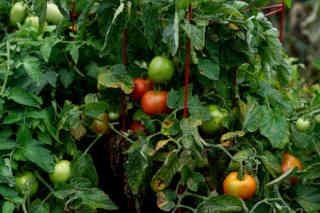By Katharine Cook
As the weather begins to warm up, many gardeners are starting to plant their tomatoes. However, growing happy and healthy tomato plants can be harder than you think, often complicated by disease or pests.

For centuries, Native Americans used companion planting, which they called the three sisters – squash, corn and beans – to reduce weed and pest pressure. According to Joe Masabni, Ph.D., Texas A&M AgriLife Extension Service vegetable specialist from the Department of Horticultural Sciences, combining plants allows for fewer weeds and more resources and structures for the plants to grow on. For example, squash provides ground cover to shade weed growth and reduce soil moisture losses from the sun, while corn provides structure for beans. Beans, a legume, are nitrogen-fixing plants that feed the squash and corn.
Companion planting is still used today and can be especially beneficial for tomato plants to protect against harm in your garden.
Benefits of companion planting
Companion planting provides a variety of benefits. Plant species combinations attract pollinators and beneficial insects that feed on pests. They can also draw pests away from garden plants like tomatoes.
“Sometimes, companion plants protect against the insect,” Masabni said. “There is the concept of a trap crop, where one of the two crops will attract the insect more.”
This improves the likelihood that insects will leave production plants alone. Masabni says trap crops can also attract beneficial insects or parasites that will protect the garden by reducing pest populations.

Not all companion plants are vegetables. Wildflowers or native flowers attract native predators. They also can beautify your garden.
“Sunflower is a great companion plant for tomatoes because it attracts stink bugs,” he said. “However, you must plant your sunflower earlier, so they start to flower when your tomato most needs protection.”
Paying attention to the timing of your companion plants is important. You want your plants to be timed to work together; otherwise, there will be no benefit.
Picking the perfect pairings for tomato plants
Masabni recommends planting tomatoes with broccoli, carrots and celery. In his personal experience, basil and onions can also be great options.
“When I plant my tomatoes with two or three rows of onions, I find that rabbits will not jump over the onions and go straight to my tomato fruits. The onions act as a barrier.”
Basil is also a great indicator plant for tomatoes. He finds basil will show powdery mildew and other diseases before it shows on a tomato plant. It may be too late to spray if you wait until the disease shows up on the tomatoes.
Masabni also notes that basil has no connection to the taste of tomatoes, even though some believe growing basil near tomato plants improves the flavor.
How to organize your companion plants
Concerning the layout of your garden, there is no universal pattern for companion planting. However, Masabni advises against planting alternating plants in the same row.
“If the plants are one row apart or each in one bed next to one another, that is sufficient,” he said. “If you have a small backyard garden, it’s still beneficial because it is in the same location.”
A common misconception is that plants must be right beside each other or touching to be considered companion planting. Masabni says this is untrue and that companion plants can still be beneficial up to five feet away from tomato plants.
With the rise in popularity of square-foot gardening, Masabni says companion planting is an excellent use of intensive gardening in a raised bed or limited space that allows for a variety of crops to be next to one another.
While companion planting is highly beneficial for protecting your tomato plants, Masabni warns that it does not offer full protection all season. The companion plants must be in season to offer maximum benefits. It’s important to keep an eye on your companion plants to ensure pest populations are not getting out of control to where they may impact your tomato plants.
Source : tamu.edu